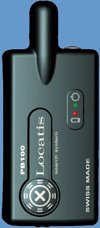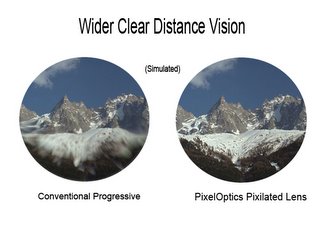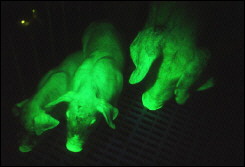Weather Democracy Map
Weather democracy in action: the people speak.
If you suspect that the television weatherman is lying to you you can check up on him yourself.
 Weather Underground
Weather Underground has created a google maps application to display personal weather stations.
Check out the
real local weather.
Personal Weather Stations Google Map : Weather Underground
Urinal Advertising
"The world of "Interactive" Urinal Advertising is endless... HAUB (Heat Activated Urinal Billboards) has taken heat sensitive ink technology to a new level. This innovative medium combines high definition color graphics, hidden by "disappearing ink" delivering an interactive message to a captive audience... A perfect strategy to get your message across."

HAUB will deliver your message when a male urinates on the board, it will reset to a black poster when the urinal does an automatic flush, ready for the next visitor.
H.A.U.B | Innovative Solutions Oceania
search by sketch
I haven't posted an internet time waster in awhile.
Here's one that should keep you busy for a minute or two.
retrievr searches
flickr for images that match your sketch. There is a box where you pick colors and pen size to express your need. The site goes out and collects pictures that may match.
It is hoplessly inefective. maybe it's because I can't sketch very well. I tried to get a red car and got mostly red things back, but no cars.

When I tried to draw a person I kept getting frog pictures.
Anyway it will be a good idea one day.
retrievr - search by sketch
Do You Know Where Your Dog Is?

A swiss company,
Locatis, is offering a GPS dog tracker.
Attach the little unit to your dog (or other loose mammal) and you can find out where they are at any time.
You can get their location from the web, SMS or call up and ask the service.
Locatis :: search system
Cat Feces and Schizophrenia
Scientists find stronger evidence for link between cat faeces and schizophrenia
Dr Joanne Webster from
Imperial College London,lead researcher.
Research published today in Procedings of the Royal Society B, shows how the invasion or replication of the parasite Toxoplasma gondii in rats may be inhibited by using anti-psychotic or mood stabilising drugs.

The researchers tested anti-psychotic and mood stabilising medications used for the treatment of schizophrenia on rats infected with T. gondii and found they were as, or more, effective at preventing behaviourial alterations as anti-T. gondii drugs. This led them to believe that T. gondii may have a role in the development of some cases of schizophrenia.
When the rats were given Haloperidol, an anti-psychotic, and Valporic acid, a mood stabiliser, the behavioural symptoms of T.gondii were reduced. They found the drugs were able to limit the suicidal feline attraction by which the rats became less aware of the dangers of cats.
Imperial College London - Scientists find stronger evidence for link between cat faeces and schizophrenia
Wasps Deliver Deadly Virus
Jia Hepeng and Wu Chong
11 January 2006
Source: SciDev.Net
[BEIJING] Chinese scientists have developed a way to protect crops using wasps that deliver lethal viruses to insect pests.
The technique, developed at the
Wuhan Virus Research Institute won second prize at the 2005 National Technological Invention Awards, which were presented at the National Science and Technology Congress in Beijing on Monday (9 January).
Lead resear

cher Peng Huiyin says the approach costs 25-40 per cent less than chemical pesticides and is more environmentally friendly. It can control more than 20 insect pests, mainly caterpillars, he adds.
Both viruses and parasitic wasps have been used to kill pests before, but the Chinese scientists are the first to combine the tactics, says co-researcher Zhang Lin.
Certain parasitic wasps lay their eggs in those of other insects. The wasp larvae feed there, killing their hosts before hatching.
Zhang says that during 15 years of research, the team has identified more than 20 viruses that kill different pests but not the wasp.
Field trials of the methods have been conducted on more than 13,000 hectares of farmland in China. "It is very likely to be commercialised within one or two years," says Zhang.
Wasps deliver deadly virus to crop pests - SciDev.Net
Eye Repair Nano Battery Implant
More on research into eyesight improvement.
Another article described an adaptive lens technology.
This announcement is about nanobatteries for artificial retina implants.
As far as I know, glasses, contact lenses and even corrective eye surgery are allowed for athletes. How far will they be allowed to go? What of the eye surgery gives the athlete an advantage over all of their oponents? Will this be banned from sports like steroids? Will it be detectable?

ALBUQUERQUE, N.M. — Several researchers from
Sandia National Laboratories, led by principal investigator Susan Rempe, are part of a multi-institutional, multidisciplinary team developing a nano-size battery that one day could be implanted in the eye to power an artificial retina.
They are among the recipients of a five-year, $6.5 million grant recently awarded by the National Eye Institute of the National Institutes of Health (NIH) to establish a new center, the National Center for Design of Biomimetic Nanoconductors. Based at the
University of Illinois Urbana-Champaign under the direction of principal investigator
Eric Jakobsson, the center is designed to rapidly launch revolutionary ideas in the use of nanomedicine.
The first task for the center will be to design a class of devices for generating electric power — bio-batteries — for a wide array of implantable devices, starting with an artificial retina that has already been developed at the
Doheny Eye Institute at the
University of Southern California. The artificial retina and accompanying nanobattery will be used to correct certain types of macular degeneration.
Sandia researchers to model nano-size battery to be implanted in eye to power artificial retina: "University of Southern California"
US Military Invests in 'Super Vision'
ROANOKE, Va. --
PixelOptics will receive $3.5 million from the Defense Department to develop eyewear designed to enhance the vision of military personnel in combat zones, the company announced Wednesday.
The technology "is intended to provide the U.S. military forces with a competitive combat advantage and reduce the number of friendly fire incidents," Ron Blum, president and chief executive officer of the Roanoke-based vision technology development company, said in a statement.

Dr. Dwight Duston, Pixel's Executive Vice President of Research and Development and Military Programs and program manager for the project, stated: "Certain nonuniformities within the human eye are the cause of most vision deficiencies. Conventional aberrations, such as nearsightedness (myopia) and farsightedness (hyperopia), can be corrected with normal spectacle lenses to give 20/20 vision.
The spatial density of light receptors in the retina, however, is enough to allow human eyes to see better than 20/20, perhaps as well as 20/08. However, higher-order aberrations in the eye prevent us from attaining this "SuperVision" (the ability to have optimized vision better than 20/20).
spacewar.comLast week, the San Diego-based Boston Health Group agreed to provide PixelOptics with $32 million to help develop eyeglasses using the same technology that could replace bifocals and trifocals. Sensors and other electronics automatically would change the lenses' focus for near and far distances.
The electro-active technology has a variety of uses, from eyeglasses to the canopies of fighter jets to automotive mirrors. But the first market is for people suffering from presbyopia, a condition affecting most people over 40.
With "93 percent of everybody in the world over the age of 42 [being] presbyoptic," according to Blum, the potential market is huge. PixelOptics plans to cash in on it.
Va. company will design eyewear to aid military in combat zones
Transgenic GlowPigs
The team from Taiwan, where the world's first genetically engineered fluorescent fish were created in 2003, injected a protein extracted from jelly fish into the nucleus of a pig embryo to breed three male transgenic pigs, said
Professor Wu Shinn-Chih, of
National Taiwan University's Institute and Department of Animal Science and Technology.
"Yes, this is really important. It should be helpful in the acceleration of clinical research of human stem cells as it is generally believed that physically pigs are among the animals which are most similar to human beings," he told AFP.

"I'm not sure if there are fluorescent green pigs elsewhere in the world, but so far, in the photos available in the field, I have never seen such pigs, whose whole bodies can glow green in the dark," Wu said.
Wu dismissed concerns that the technology could endanger the ecosystem.
"There is no need to worry about that because, unlike fish, the confined green pigs have no way to crossbreed with wild species and produce 'Frankenpigs'," he said.
And green pigs might flyLabels: Glowing Animals
The Economic Theory of Illegal Goods
How elasticity affects the market for illegal goods
In an important new study, world-renowned economists--including a Nobel Prize winner and a MacArthur "genius"--argue that when demand for a good is inelastic, the cost of making consumption illegal exceeds the gain. Their forthcoming paper in the
Journal of Political Economy is a definitive explanation of the economics of illegal goods and a thoughtful explication of the costs of enforcement.
The authors demonstrate how the elasticity of demand is crucial to understanding the effects of punishment on suppliers.
Enforcement raises costs for suppliers, who must respond to the risk of imprisonment and other punishments. This cost is passed on to the consumer, which induces lower consumption when demand is relatively elastic.
However, in the case of illegal goods like drugs--where demand seems inelastic--higher prices lead not to less use, but to an increase in total spending.
In the case of drugs, then, the authors argue that excise taxes and persuasive techniques –such as advertising--are far more effective uses of enforcement expenditures.
"This analysis…helps us understand why the War on Drugs has been so difficult to win…why efforts to reduce the supply of drugs leads to violence and greater power to street gangs and drug cartels," conclude the authors. "The answer lies in the basic theory of enforcement developed in this paper."
How elasticity affects the market for illegal goods
Computers Want To Know How You Feel
Experts have identified aggression towards the PC as a genuine problem that deserves greater attention in the academic field.
It would be good for computers to assess their users’ emotions correctly and
respond accordingly.
The first question asked by scientists at the
Fraunhofer Institute for Computer Graphics Research IGD in Rostock was: How can the computer possibly find out anything about its human operator’s frame of mind?
Emotions are given away by peripheral physiological processes. Some of these, such as posture, fidgeting or frowning, are easy to detect and can be observed and classified by a camera with image analysis software. Heartbeat and breathing rate, blood pressure, skin temperature and electrical resistance of the skin, on the other hand, are rather more subtle factors.
“We have developed a glove that has sensors for measuring parameters like these,” says Christian Peter, engineer at the department for Human-Centered Interaction Technologies. “It is connected to a device that evaluates and saves the data. We are also working on techniques that will enable computers to interpret facial expressions and extract emotional elements from voice signals.”
Computers Estimate Emotions
Buckypaper is stronger than steel at a fraction of the weight
Florida State Universityby Barry Ray
Working with a material 10 times lighter than steel—but 250 times stronger—would be a dream come true for any engineer.
One Florida State University research group, the
Florida Advanced Center for Composite Technologies (FAC2T), is working to develop real-world applications for just such a material.
Ben Wang, a professor of industrial engineering at the Florida A&M University-FSU College of Engineering, serves as director of FAC2T, which works to develop new, high-performance composite materials, as well as technologies for producing them.
"At FAC2T, our objective is to push the envelope to find out just how strong a composite material we can make using buckypaper," Wang said. "In addition, we're focused on developing processes that will allow it to be mass-produced cheaply."
Buckypaper owes its name to Buckminsterfullerene, or Carbon 60—a type of carbon molecule whose powerful atomic bonds make it twice as hard as a diamond.
Buckypaper has shown promise in a variety of applications, including the development of aerospace structures, the production of more-effective body armor and armored vehicles, and the construction of next-generation computer displays.
Among the possible uses for buckypaper that are being researched at FAC2T:
If exposed to an electric charge, buckypaper could be used to illuminate computer and television screens.
As one of the most thermally conductive materials known, buckypaper lends itself to the development of heat sinks that would allow computers and other electronic equipment to disperse heat more efficiently than is currently possible.
Films also could protect electronic circuits and devices within airplanes from electromagnetic interference,
Similarly, such films could allow military aircraft to shield their electromagnetic "signatures," which can be detected via radar.
FSU researcher's "buckypaper" is stronger than steel at a fraction of the weight
Where have you been?
This may not be the funniest joke ever, but it is kind of funny.










